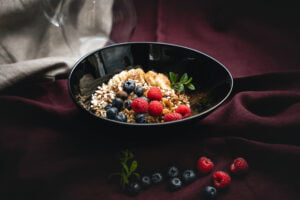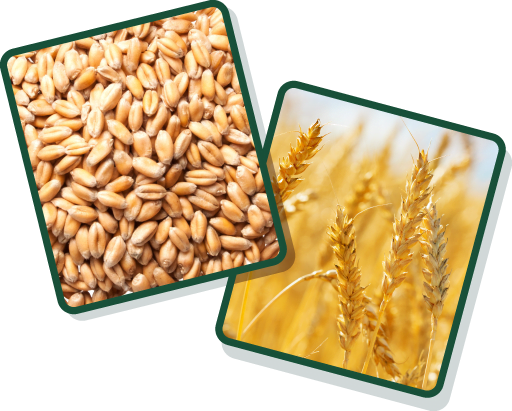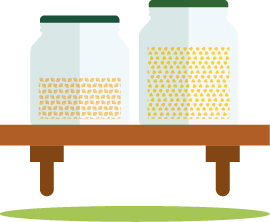
Wheat encompasses a variety of grains that fall under the wheat family, including “common” wheat (used in most breads and flours) as well as ancient wheat varieties such as einkorn (small farro), emmer (medium farro), and spelt (big farro).
There are two main types of wheat commonly eaten: durum wheat, which is used to make pasta, and bread wheat, which is used for most other wheat-based foods. Bread wheat is classified based on its protein content (as ‘hard’ or ‘soft), the season it is planted (as ‘winter’ or ‘spring’), and the colour of the kernels (as ‘red’ or ‘white’). For example, hard wheat has a higher protein and gluten content and is typically used for bread. Soft wheat has a lower protein content and is ideal for making cake flour. Winter and spring wheat differ primarily in their growing regions.
Whole wheat has a hearty and slightly nutty flavour. It pairs well with nearly everything.

Nutritionally, whole wheat bread is high in fibre and is a source of magnesium, phosphorus, and copper. You can substitute wheat flour for whole wheat flour by up to 50% in a recipe to make it more nutritious.
Wheat contains gluten, so it is not suitable for those with gluten intolerance or coeliac disease.

Toggle with the tables below to compare their nutritional content per 100 g (both cooked and uncooked) and per average portion size. You might be surprised by the differences!
| Grains | Kcal | Protein | Fat | Saturated fat | Carbohydrates | Fibre |
|---|---|---|---|---|---|---|
| Wheat flour, Per 100 g, uncooked | 335.00 | 10 | 1 | 0 | 69 | 3 |
| White bread, Per 100 g, cooked | 247.00 | 9 | 1 | 0 | 47 | 2 |
| White pasta, Per 100 g, cooked | 142.00 | 5 | 0 | 0 | 27 | 1 |
| White pasta, Per 100 g, uncooked | 356.00 | 12 | 1 | 0 | 72 | 3 |
| Whole grain pasta, Per 100 g, cooked | 134.00 | 5 | 0 | 0 | 23 | 4 |
| Whole grain pasta, Per 100 g, uncooked | 348.00 | 13 | 2 | 0 | 66 | 6 |
| Whole wheat bread, Per 100 g, cooked | 234.00 | 11 | 2 | 0 | 39 | 6 |
| Whole wheat flour, Per 100 g, uncooked | 330.00 | 14 | 2 | 0 | 58 | 10 |
| Multigrain bread, Per 100 g, cooked | 261.00 | 12 | 4 | 0 | 39 | 6 |
| Brown bread, Per 100 g, cooked | 236.00 | 9 | 1 | 0 | 42 | 5 |
| Couscous, Per 100 g, cooked | 121.00 | 4 | 0 | 0 | 24 | 1 |
| Couscous, Per 100 g, uncooked | 363.00 | 12 | 2 | 0 | 72 | 3 |
| Whole wheat couscous, Per 100 g, cooked | 114.00 | 4 | 0 | 0 | 21 | 2 |
| Whole wheat couscous, Per 100 g, uncooked | 342.00 | 12 | 1 | 0 | 65 | 8 |
Whole grains are all packed with carbohydrates and dietary fibre (which is a type of carbohydrate) and are naturally low in (saturated) fat. Fibre is important for our health and the prevention of many chronic diseases. That’s why the European Food Safety Authority (EFSA) recommends we eat at least 25 g of fibre per day. Sometimes, you might see whole grains labelled as ‘high in fibre’ or ‘source of fibre’ – but what does that really mean?
| Grains (% of DRV) | Calcium | Magnesium | Phosphorus | Potassium | Iron | Zinc | Copper | Vit. B1 | Vit. B2 | Vit. B3 | Vit. B6 | Folate |
|---|---|---|---|---|---|---|---|---|---|---|---|---|
| Wheat flour, per 100 g, uncooked | 2.88 | 5.33 | 14.71 | 7.80 | 5.71 | 6.40 | 14.00 | 6.36 | 2.86 | 6.25 | 8.57 | 6.67 |
| White bread, per 100 g, cooked | 3.63 | 5.07 | 12.00 | 5.75 | 5.71 | 6.00 | 12.00 | 5.45 | 2.86 | 5.63 | 2.29 | 6.67 |
| White bread, per portion, cooked | 1.09 | 1.52 | 3.60 | 1.73 | 1.71 | 1.80 | 3.60 | 1.64 | 0.86 | 1.69 | 0.69 | 2.00 |
| White pasta, per 100 g, cooked | 2.00 | 5.07 | 10.57 | 2.40 | 5.00 | 6.40 | 12.00 | 2.73 | 2.14 | 6.25 | 1.29 | 1.36 |
| White pasta, per 100 g, uncooked | 1.88 | 14.13 | 17.86 | 5.00 | 14.29 | 15.00 | 30.00 | 9.09 | 4.29 | 12.50 | 5.71 | 3.33 |
| White pasta, per portion, cooked | 1.50 | 3.80 | 7.93 | 1.80 | 3.75 | 4.80 | 9.00 | 2.05 | 1.61 | 4.69 | 0.96 | 1.02 |
| White pasta, per portion, uncooked | 1.41 | 10.60 | 13.39 | 3.75 | 10.71 | 11.25 | 22.50 | 6.82 | 3.21 | 9.38 | 4.29 | 2.50 |
| Multigrain bread, per 100 g, cooked | 5.63 | 15.20 | 24.00 | 11.00 | 12.86 | 12.40 | 24.00 | 10.91 | 5.00 | 10.63 | 6.36 | 11.61 |
| Multigrain bread, per portion, cooked | 1.97 | 5.32 | 8.40 | 3.85 | 4.50 | 4.34 | 8.40 | 3.82 | 1.75 | 3.72 | 2.23 | 4.06 |
| Whole grain pasta, per 100 g, cooked | 3.13 | 12.53 | 18.43 | 3.50 | 12.14 | 13.00 | 22.00 | 9.09 | 1.43 | 15.63 | 0.21 | 3.24 |
| Whole grain pasta, per 100 g, uncooked | 5.00 | 32.00 | 57.86 | 25.00 | 23.57 | 30.00 | 51.00 | 43.64 | 10.00 | 38.75 | 28.57 | 7.27 |
| Whole grain pasta, per portion, cooked | 2.34 | 9.40 | 13.82 | 2.63 | 9.11 | 9.75 | 16.50 | 6.82 | 1.07 | 11.72 | 0.16 | 2.43 |
| Whole grain pasta, per portion, uncooked | 3.75 | 24.00 | 43.39 | 18.75 | 17.68 | 22.50 | 38.25 | 32.73 | 7.50 | 29.06 | 21.43 | 5.45 |
| Whole wheat bread, per 100 g, cooked | 4.25 | 17.60 | 28.57 | 13.35 | 14.29 | 14.10 | 22.00 | 10.00 | 5.00 | 10.00 | 7.36 | 12.18 |
| Whole wheat bread, per portion, cooked | 1.49 | 6.16 | 10.00 | 4.67 | 5.00 | 4.94 | 7.70 | 3.50 | 1.75 | 3.50 | 2.58 | 4.26 |
| Whole wheat flour, per 100 g, uncooked | 3.75 | 33.07 | 52.86 | 12.50 | 28.57 | 29.00 | 45.00 | 36.36 | 10.71 | 35.63 | 25.00 | 11.21 |
| Brown bread, per 100 g, cooked | 3.63 | 11.47 | 20.29 | 9.60 | 10.00 | 10.00 | 16.00 | 8.18 | 4.29 | 7.50 | 5.14 | 8.09 |
| Brown bread, per portion, cooked | 1.27 | 4.01 | 7.10 | 3.36 | 3.50 | 3.50 | 5.60 | 2.86 | 1.50 | 2.63 | 1.80 | 2.83 |
| Couscous, per 100 g, cooked | 1.63 | 5.33 | 11.29 | 4.80 | 5.00 | 6.00 | 13.00 | 8.18 | 1.43 | 5.63 | 3.57 | 2.82 |
| Couscous, per 100 g, uncooked | 3.50 | 15.73 | 34.00 | 14.35 | 14.29 | 18.00 | 36.00 | 25.45 | 4.29 | 16.25 | 10.71 | 8.48 |
| Couscous, per portion, cooked | 1.14 | 3.73 | 7.90 | 3.36 | 3.50 | 4.20 | 9.10 | 5.73 | 1.00 | 3.94 | 2.50 | 1.97 |
| Couscous, per portion, uncooked | 2.45 | 11.01 | 23.80 | 10.05 | 10.00 | 12.60 | 25.20 | 17.82 | 3.00 | 11.38 | 7.50 | 5.94 |
| Whole wheat couscous, per 100 g, cooked | 1.63 | 11.20 | 17.57 | 4.20 | 9.29 | 9.70 | 16.00 | 11.82 | 3.57 | 11.88 | 8.36 | 3.73 |
| Whole wheat couscous, per 100 g, uncooked | 3.75 | 33.07 | 52.86 | 12.50 | 28.57 | 29.00 | 45.00 | 36.36 | 10.71 | 35.63 | 25.00 | 11.21 |
| Whole wheat couscous, per portion, cooked | 1.14 | 7.84 | 12.30 | 2.94 | 6.50 | 6.79 | 11.20 | 8.27 | 2.50 | 8.31 | 5.85 | 2.61 |
| Whole wheat couscous, per portion, uncooked | 2.63 | 23.15 | 37.00 | 8.75 | 20.00 | 20.30 | 31.50 | 25.45 | 7.50 | 24.94 | 17.50 | 7.85 |
% of DRV stands for dietary reference value. DRV stands for dietary reference value. These values estimate how much of a nutrient most healthy people in Europe need each day. Ideally, we should aim to reach 100% of these values daily. Each vitamin and mineral has their own DRV, as set by EFSA.
You might have heard that whole grains are ‘high in,’ ‘rich in,’ or ‘source of’ a certain vitamin or mineral. These term are regulated by EFSA and products must meet specific rules to be considered as such. Here’s how to interpret these contributions:

Store in an airtight container in a cool, dry place. Follow the instructions on the packaging to keep the food good for as long as possible.
Whole wheat has a best-before date, meaning that it can often be eaten after that date has passed. If they look, smell and taste good, and the packaging is also intact, it will most likely be safe.

Cooking times and methods vary depending on the specific whole wheat grain and recipe it is used in. Follow the instructions on the packaging, as cooking times can vary.

Refined wheat products, such as white flour or products labelled simply as “wheat flour”, have had the bran and germ removed, which strips away most of the fibre, vitamins, and minerals. In contrast, whole wheat products, whether in the form of whole grains, flour, or products like bread and pasta, retain all parts of the grain (bran, germ, and endosperm) and are considered whole grain.
Learn to identify whole grain products, cook delicious meals, find practical tips for a smooth, gradual switch, and much more!